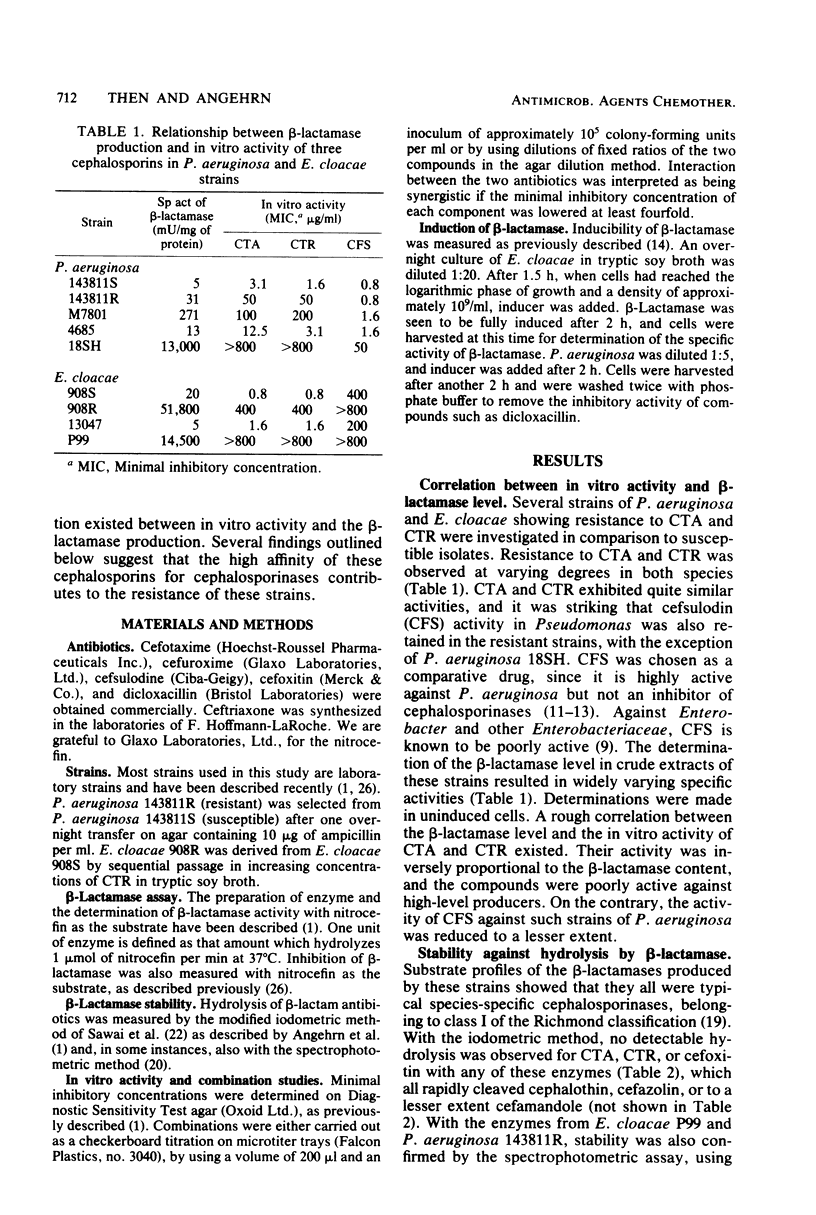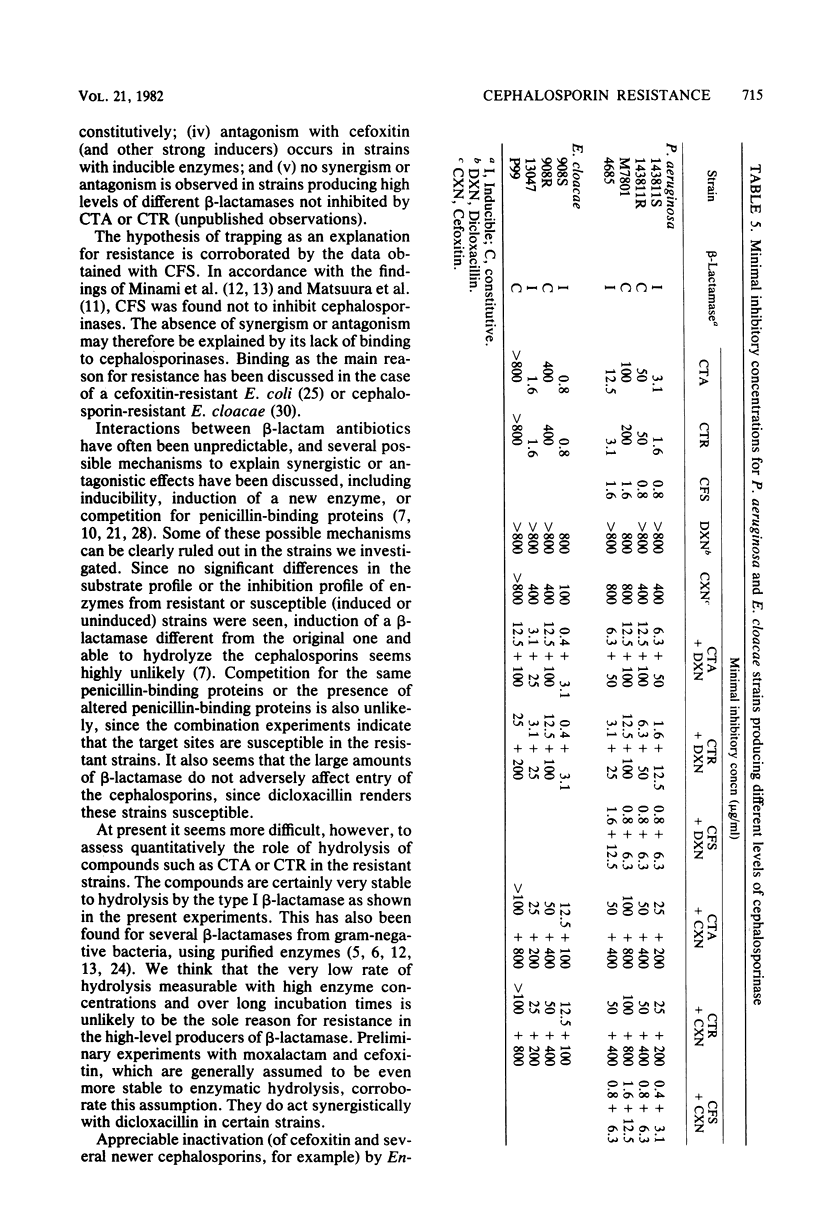Abstract
Resistance to cefotaxime (CTA) and ceftriaxone (CTR) in Enterobacter cloacae and Pseudomonas aeruginosa was investigated in several strains which are susceptible or resistant to these agents. All strains produced a chromosomally mediated cephalosporinase of the Richmond type 1. beta-Lactamases in susceptible strains were inducible, whereas resistant strains produced the enzymes constitutively. CTA and CTR were very poor substrates but potent inhibitors of all enzymes. Binding to, rather than hydrolysis by, beta-lactamases was assumed to be a major reason for resistance, and combination experiments supported this assumption. Dicloxacillin, which did not inhibit the growth and which was a poor inducer but a strong inhibitor of these beta-lactamases, exerted strong synergistic activity when combined with CTA or CTR in strains which produced large amounts of beta-lactamase constitutively. Cefoxitin, on the other hand, poorly active alone, but a good inducer, strongly antagonized CTA or CTR in susceptible strains producing inducible enzymes. In marked contrast to CTA and CTR were the findings with cefsulodin. Cefsulodin was active against CTA- and CTR-resistant Pseudomonas, and its activity was hardly influenced by dicloxacillin or cefoxitin. Since cefsulodin was found to have a very low affinity for all cephalosporinases, these findings corroborate the assumption that binding of nonhydrolyzable cephalosporins, rather than hydrolysis by cephalosporinases, may play an important role in resistance to these agents and other newer cephalosporins in Enterobacteriaceae, as well as in other gram-negative bacteria.
Full text
PDF






Selected References
These references are in PubMed. This may not be the complete list of references from this article.
- Angehrn P., Probst P. J., Reiner R., Then R. L. Ro 13-9904, a long-acting broad-spectrum cephalosporin: in vitro and in vivo studies. Antimicrob Agents Chemother. 1980 Dec;18(6):913–921. doi: 10.1128/aac.18.6.913. [DOI] [PMC free article] [PubMed] [Google Scholar]
- English A. R., Retsema J. A., Girard A. E., Lynch J. E., Barth W. E. CP-45,899, a beta-lactamase inhibitor that extends the antibacterial spectrum of beta-lactams: initial bacteriological characterization. Antimicrob Agents Chemother. 1978 Sep;14(3):414–419. doi: 10.1128/aac.14.3.414. [DOI] [PMC free article] [PubMed] [Google Scholar]
- Farrar W. E., Jr, Newsome J. K. Mechanism of synergistic effects of beta-lactam antibiotic combinations on gram-negative bacilli. Antimicrob Agents Chemother. 1973 Aug;4(2):109–114. doi: 10.1128/aac.4.2.109. [DOI] [PMC free article] [PubMed] [Google Scholar]
- Fisher J., Belasco J. G., Khosla S., Knowles J. R. beta-Lactamase proceeds via an acyl-enzyme intermediate. Interaction of the Escherichia coli RTEM enzyme with cefoxitin. Biochemistry. 1980 Jun 24;19(13):2895–2901. doi: 10.1021/bi00554a012. [DOI] [PubMed] [Google Scholar]
- Fu K. P., Neu H. C. The comparative beta-lactamase resistance and inhibitory activity of 1-oxa cephalosporin, cefoxitin and cefotaxime. J Antibiot (Tokyo) 1979 Sep;32(9):909–914. doi: 10.7164/antibiotics.32.909. [DOI] [PubMed] [Google Scholar]
- Fu K. P., Neu H. C. The role of inducible beta-lactamases in the antagonism seen with certain cephalosporin combinations. J Antimicrob Chemother. 1981 Jan;7(1):104–107. doi: 10.1093/jac/7.1.104. [DOI] [PubMed] [Google Scholar]
- Fu K. P., Neu H. C. beta-lactamase stability of HR 756, a novel cephalosporin, compared to that of cefuroxime and cefoxitin. Antimicrob Agents Chemother. 1978 Sep;14(3):322–326. doi: 10.1128/aac.14.3.322. [DOI] [PMC free article] [PubMed] [Google Scholar]
- Hamilton-Miller J. M. The demonstration and significance of synergism between -lactam antibiotics. J Med Microbiol. 1971 May;4(2):227–237. doi: 10.1099/00222615-4-2-227. [DOI] [PubMed] [Google Scholar]
- King A., Shannon K., Phillips I. In vitro antibacterial activity and susceptibility of cefsulodin, an antipseudomonal cephalosporin, to beta-lactamases. Antimicrob Agents Chemother. 1980 Feb;17(2):165–169. doi: 10.1128/aac.17.2.165. [DOI] [PMC free article] [PubMed] [Google Scholar]
- Kuck N. A., Testa R. T., Forbes M. In vitro and in vivo antibacterial effects of combinations of beta-lactam antibiotics. Antimicrob Agents Chemother. 1981 Apr;19(4):634–638. doi: 10.1128/aac.19.4.634. [DOI] [PMC free article] [PubMed] [Google Scholar]
- Matsuura M., Nakazawa H., Inoue M., Mitsuhashi S. Purification and biochemical properties of beta-lactamase produced by Proteus rettgeri. Antimicrob Agents Chemother. 1980 Nov;18(5):687–690. doi: 10.1128/aac.18.5.687. [DOI] [PMC free article] [PubMed] [Google Scholar]
- Minami S., Inoue M., Mitsuhashi S. Purification and properties of a cephalosporinase from Enterobacter cloacae. Antimicrob Agents Chemother. 1980 Dec;18(6):853–857. doi: 10.1128/aac.18.6.853. [DOI] [PMC free article] [PubMed] [Google Scholar]
- Minami S., Inoue M., Mitsuhashi S. Purification and properties of cephalosporinase in Escherichia coli. Antimicrob Agents Chemother. 1980 Jul;18(1):77–80. doi: 10.1128/aac.18.1.77. [DOI] [PMC free article] [PubMed] [Google Scholar]
- Minami S., Yotsuji A., Inoue M., Mitsuhashi S. Induction of beta-lactamase by various beta-lactam antibiotics in Enterobacter cloacae. Antimicrob Agents Chemother. 1980 Sep;18(3):382–385. doi: 10.1128/aac.18.3.382. [DOI] [PMC free article] [PubMed] [Google Scholar]
- O'Callaghan C., Morris A. Inhibition of beta-lactamases by beta-lactam antibiotics. Antimicrob Agents Chemother. 1972 Dec;2(6):442–448. doi: 10.1128/aac.2.6.442. [DOI] [PMC free article] [PubMed] [Google Scholar]
- Okonogi K., Kuno M., Kida M., Mitsuhashi S. Beta-lactamase stability and antibacterial activity of cefmenoxime (SCE-1365), a novel cephalosporin. Antimicrob Agents Chemother. 1981 Aug;20(2):171–175. doi: 10.1128/aac.20.2.171. [DOI] [PMC free article] [PubMed] [Google Scholar]
- Reading C., Cole M. Clavulanic acid: a beta-lactamase-inhiting beta-lactam from Streptomyces clavuligerus. Antimicrob Agents Chemother. 1977 May;11(5):852–857. doi: 10.1128/aac.11.5.852. [DOI] [PMC free article] [PubMed] [Google Scholar]
- Richmond M. H., Sykes R. B. The beta-lactamases of gram-negative bacteria and their possible physiological role. Adv Microb Physiol. 1973;9:31–88. doi: 10.1016/s0065-2911(08)60376-8. [DOI] [PubMed] [Google Scholar]
- Richmond M. H. The beta-lactamase stability of a novel beta-lactam antibiotic containing a 7 alpha-methoxyoxacephem nucleus. J Antimicrob Chemother. 1980 Jul;6(4):445–453. doi: 10.1093/jac/6.4.445. [DOI] [PubMed] [Google Scholar]
- Ross G. W., O'Callaghan C. H. Beta-lactamase assays. Methods Enzymol. 1975;43:69–85. doi: 10.1016/0076-6879(75)43081-6. [DOI] [PubMed] [Google Scholar]
- Sanders C. C., Sanders W. E., Jr Emergence of resistance to cefamandole: possible role of cefoxitin-inducible beta-lactamases. Antimicrob Agents Chemother. 1979 Jun;15(6):792–797. doi: 10.1128/aac.15.6.792. [DOI] [PMC free article] [PubMed] [Google Scholar]
- Sawai T., Takahashi I., Yamagishi S. Iodometric assay method for beta-lactamase with various beta-lactam antibiotics as substrates. Antimicrob Agents Chemother. 1978 Jun;13(6):910–913. doi: 10.1128/aac.13.6.910. [DOI] [PMC free article] [PubMed] [Google Scholar]
- Selwyn S., Bakhtiar M. Inactivation of cephalosporins in blood cultures and mixed assays with a commercially available enterobacter beta-lactamase. J Antimicrob Chemother. 1979 May;5(3):318–320. doi: 10.1093/jac/5.3.318. [DOI] [PubMed] [Google Scholar]
- Tajima M., Takenouchi Y., Sugawara S., Inoue M., Mitsuhashi S. Purification and properties of chromosomally mediated beta-lactamase from Citrobacter freundii GN7391. J Gen Microbiol. 1980 Dec;121(2):449–456. doi: 10.1099/00221287-121-2-449. [DOI] [PubMed] [Google Scholar]
- Takahashi I., Sawai T., Ando T., Yamagishi S. Cefoxitin resistance by a chromosomal cephalosporinase in Escherichia coli. J Antibiot (Tokyo) 1980 Sep;33(9):1037–1042. doi: 10.7164/antibiotics.33.1037. [DOI] [PubMed] [Google Scholar]
- Then R. L. Properties of Ro 13-99041 as a substrate and inhibitor of beta-lactamases. Chemotherapy. 1981;27 (Suppl 1):25–31. doi: 10.1159/000238025. [DOI] [PubMed] [Google Scholar]
- Toda M., Ikeuchi T., Tajima M., Inoue M., Mitsuhashi S. Comparative inhibition of beta-lactamases by cephamycin antibiotics. J Antibiot (Tokyo) 1981 Jan;34(1):114–117. doi: 10.7164/antibiotics.34.114. [DOI] [PubMed] [Google Scholar]
- Wise R., Andrews J. M., Bedford K. A. Clavulanic acid and CP-45,899: a comparison of their in vitro activity in combination with penicillins. J Antimicrob Chemother. 1980 Mar;6(2):197–206. doi: 10.1093/jac/6.2.197. [DOI] [PubMed] [Google Scholar]


